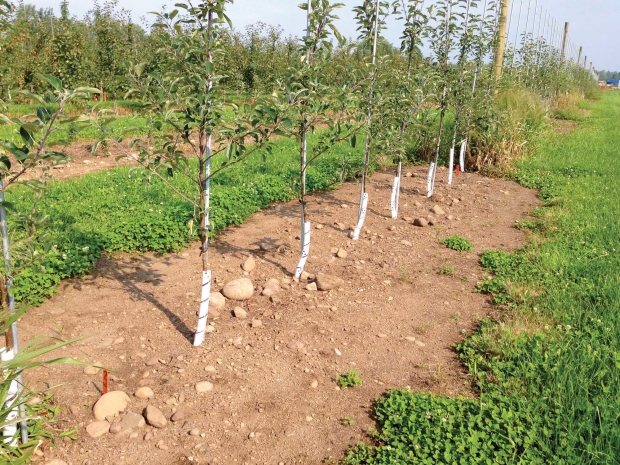
Tests on critical timing of weed control were conducted last year in this planting of Gala on Malling 9 at a 3-by-12-foot spacing. (Courtesy of Deborah Breth)
Good weed control is essential during the early lives of trees in high-density apple orchards, as growers are intent on growing them to the top trellis wire in the first two years after planting.
What is “good weed control?”
Essentially, it means suppressing weed competition in a yard-wide strip where the trees are growing during the months of May through July. “Good” means keeping ground cover from other vegetation to less than 20 percent of the surface area.
Deborah Breth, a tree fruit educator in the Lake Ontario Fruit Program, part of the Cornell University’s extension program in New York State, credited Cornell’s Dr. Ian Merwin and his research in the 1990s with establishing those critical times and strip width. In studies since then, those principles remain the same, even as much else has changed.
Trees have gotten smaller but are planted closer together, so there is more competition between trees and less shade from the canopy to suppress competition from other vegetation. Irrigation has joined weed control as important practices for good tree growth.
Herbicide programs can be expensive, costing $60 to $150 per treated acre per year ($20 to $50 per acre of orchard), Breth said, but the cost of weed management is less than 1 percent of the annual cost of production and should not be considered an important factor in choosing herbicide. The economic impact of poor control can be great.
“There is a potential for $1,600 to $2,900 per acre lost in Gala yield by the third leaf if weeds are not controlled in May through July,” Breth said.
Those numbers were based on studies at Cornell.
One problem most herbicide programs share is length of control.
“No pre-emergence herbicide in our plots gave season-long control,” she said. Using Prowl (pendimethalin), Surflan (oryzalin), or Sinbar (terbacil) as the basic residual herbicide will give control lasting 30 to 40 days, she said. Adding Chateau (flumioxazin) will extend that to 40 to 60 days. Adding GoalTender (oxyfluorfen) will get 60 to 70 days. “
Matrix (rimsulfuron) and Alion (indaziflam) have the longest residual and normally require only one additional post-emergent herbicide,” she said.
New orchards
For newly planted orchards, Breth recommends careful preplant preparation to eliminate perennial weeds. Left uncontrolled, they will be a continuing problem.
As soon as soil has settled after tree planting, apply a pre-emergence residual herbicide.
“Wait until a soil settling rainfall has occurred after tree planting to prevent the herbicides from washing down into the trees’ roots,” she advised. “Time it so you will get rainfall to incorporate the herbicide into the weed seed germination soon after application.”
For a residual herbicide in new plantings, growers can choose Prowl H20 or Surflan, alone or in combination with GoalTender or Goal by budswell or Chateau by the pink stage of bloom. Chateau requires a nonporous wrap on trunks to protect trees from sprays in new plantings.
Growers may also use lower rates of Solicam (norflurazon) or Sinbar. The first application should be mixed with a post-emergent control such as paraquat to burn any weed seedlings already emerged between planting and the first application.
Growers will need a post-emergence spray to lengthen the control, using Gramoxone (paraquat), Roundup (glyphosate), Aim (carfentrazone-ethyl) or Venue (pyraflufen-ethyl). Paraquat is a contact herbicide only and is not as effective on ragweed, while glyphosate is translocated to weed roots. Aim and Venue will only control small broadleaf weeds. None of these herbicides should be allowed to contact the bark of young or green trees.
While Alion is a new pre-emergence herbicide with long-lasting action, it is not for use on pome or stone fruit trees established less than three years. Neither Sandea (halosulfuron-methyl) nor Matrix can be used on trees established less than one year.
After trees are established at least one year, there are several other residual herbicides that can be used in the spring pre-emergence application: Simazine, diuron, and Casoron (dichlobenil, spring or fall). There are also other materials that can be used in post-emergence applications: 2,4-D, Treevix (saflufenacil), Rely (glufosinate), and Stinger (clopyralid).
One further note: Irrigation reduces the duration of the effectiveness of the residual herbicide, Breth said.
Few new
The introduction of new herbicides has slowed down, Breth said. Other than Matrix, Sandea, and Alion, there are
no new residual herbicides with new mechanisms of action in development.
“Future options will need to rely on herbicides already registered. We hope there may be new uses of existing herbicides labeled for other crops. In light of reports of weeds developing resistance to classes of herbicides, we will also need to rotate the mechanism of action in our orchards.”
In choosing a program, for example, Prowl and Surflan are not good rotation partners since they have the same mode of action—both are taken up by roots and inhibit cell division at growing points. Both Goaltender and Chateau are non-translocated herbicides that operate by destroying cell membranes.
Sinbar offers a third mode, being taken up by roots through the xylem to older leaves first, then younger leaves, inhibiting photosynthesis.
Most herbicides also have weaknesses, and growers have to know their problems in making herbicide choices. Both Prowl and Surflan are weak on ragweed; Surflan is weak on smartweed as well. Sinbar is weak on pigweed, but has, as a special plus, strength against nutsedge, quackgrass, and horsenettle. After trees are older, growers can choose Sandea if nutsedge is a special problem.
In some orchards, weeds once controlled by glyphosate no longer are. That affects which chemical may be chosen for post-emergence weed control.
Breth presented her recommendations during the International Fruit Tree Association annual conference in Halifax, Nova Scotia, in February. Because of weather problems, she made her presentation remotely from New York. •






Leave A Comment